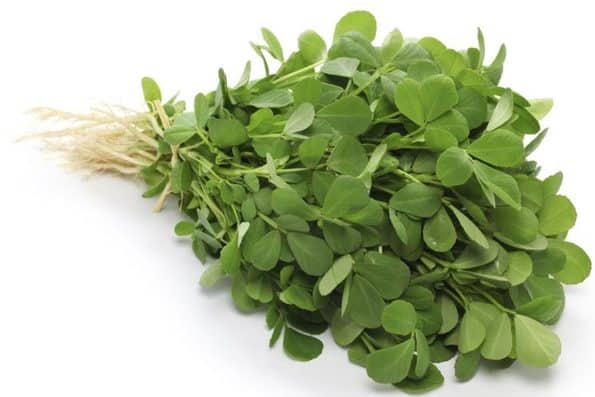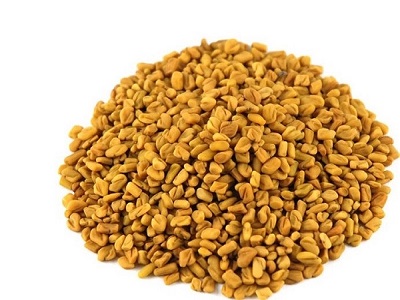Fenugreek Cultivation Guide:
Introduction to Fenugreek Cultivation:- Fenugreek is an annual herbal plant in the family of ““Legumionseae” which can consist of 3 small obovate to oblong leaflets. Fenugreek seeds are small in size with a hard and smooth texture and oblong. Usually, fenugreek seeds are yellowish brown in color. Fenugreek crop is main grown for its seeds or leaves (fresh or dried). Fenugreek is native to western Asia, South Eastern Europe, and northern Africa. However, it is being grown in most parts of the world. Fenugreek name is derived from two Latin words ‘faenugraecum’ and ‘faenum Greacum’ meaning “Greek hay”. Fenugreek is popularly known as “methi” in India. Fenugreek leaves and seeds are used in many Asian dishes. In India, every kitchen will have this excellent nature given spice. Fenugreek seeds have excellent market value. Commercial cultivation of fenugreek seeds is growing in a big way due to its tremendous health, beauty benefits, and medicinal value. Indian occupies number one place in the production of fenugreek seeds in the world.
It is one of the best ingredients in homemade remedies for many health problems. Fenugreek plants can be grown in pots, containers, indoors, backyards, playhouses, greenhouse, shade net and even hydroponically. With proper horticulture practices, one can obtain decent profits with fenugreek cultivation.

Scientific Name or Botanical Name of Fenugreek Plant:- “Trigonellia foenumgrccum L”.
Family Name of Fenugreek Plant:- “Legumionseae”.
Genus of Fenugreek Plant:- “Trigonella”.
Fenugreek Names in other Country Languages:- Fenugrec (French), Bockshornklee (German), Fenegriek (Dutch), Grek Chireg (Mongolian), Kozieradka pospolita (Polish), Fenigrec (Catalan), Fenogreco / Alholva (Spanish),
fenegriek (Afrikaans), pjeskavica (Bosnian), Kreeka lambalääts (Estonian), Bockshornklee (Greek), pe-ni-geu-rig (Korean), Methi (Nepali), Feno-grego (Portuguese), Hilbeh (Arabic), Hu lu ba (Chinese), Сминдух (Bulgarian), Fieno greco (Italian), Bukkehornkløver (Norwegian), พืชฟีนูกรีก / Luk sat (Thai),Hồ lô ba (Vietnamese),Chaiman / hulpa (Armenian), Grčko sijeno (Croatian), sarviapila (Finnish), חילבה/Chilbeh (Hebrew), Koruha / Fenu-guriku (Japanese), Sierāboliņš (Latvian), Schinduf (Romanian), Ulu Haal(Sinhalese), Uwatu (Swahili), Pískavice řecké seno / Senenka (Czech), Грчко семе (Macedonian), Пажитник (Russian), bockhornsklöver(Swedish), Poy baharatı / Çemen otu (Turkish), Bukkehorn (Danish), Solinji (Georgian), Görögszéna (Hungarian), Halba (Malay), Shanbalile (Persian), 胡蘆巴 (Taiwanese), and Methika (Sanskrit).
Fenugreek Names in Indian Languages:- Fenugreek Seeds (English), Methi Dana (Hindi), Menthulu (Telugu), Vendhayam (Tamil), Uluva/Venthiam (Malayalam), Menthe / Menthya (Kannada), Methi (Bengali,Gujarati,Konkani,Oriya), Methi Dane / Methi(Marathi), Meth / Methi(Punjabi), Menthae (Tulu), Meeth (Kashmiri), and Methe (Urdu).
Major Production Countries of Fenugreek:- The following are the major producing countries of fenugreek seed.
India, Nepal, Pakistan, Bangladesh, Spain, Turkey, Argentina, Egypt, France, Morocco, and China are top producing countries of fenugreek seed. However, India is the top producer of fenugreek seed in the world.
Major Production States of Fenugreek Seeds in India:- Maharashtra, Gujarat, Uttaranchal, Rajasthan, Madhya Pradesh, Chhattisgarh, Haryana, Punjab, and Uttar Pradesh.
Uses and Health Benefits of Fenugreek:- When it comes to uses of fenugreek, their seeds are being used as a spice in many Indian dishes. Fresh and dried leaves are used in curries. Apart from this fenugreek is used in herbal and beauty products.

The following are some of the health benefits of fenugreek seeds and leaves.
- Fenugreek seeds are excellent to control blood glucose levels hence good for diabetic patients
- Fenugreek seeds are good for milk production in lactating mothers
- Regular consumption of fenugreek seeds can promote good digestion
- Fenugreek seeds are good for weight loss
- Fenugreek seeds are good for relieving sour throat, cough, common cold and fever
- Fenugreek seeds said to be good at relieving menopausal discomfort in women
- Fenugreek seed is good for people suffering from asthma.
Varieties (Cultivars) of Fenugreek:- There are many improved varieties of fenugreek cultivated. The following are some of the popular cultivars of fenugreek grown in India; Co-1, Co-2, Methi No- 47, No- 14, Rajendra kanti, Hisar Sonali, Hisar Suvarna, Hisar Madhavi, Hisar Mukthakasuri, Pusa, Punching type, and EC- 4911. Contact your horticulture department for suitable and high yielding fenugreek variety for your region.
Climate Requirement for Fenugreek Cultivation:- Fenugreek is a cool season crop and this crop can tolerate frost conditions to some extent. Regions having high rainfalls should be avoided for growing fenugreek crop.
Soil Requirement for Fenugreek Cultivation:- Fenugreek can be grown in a wide range of soils and a rich well-drained loamy soil is best suited for its production. The ideal pH of the soil should be 6.0 to 7.0. Commercial growers should go for a soil test and based on results, any soil deficiencies should be fulfilled.
Propagation, Seed Rate and Seed Treatment in Fenugreek Cultivation:- Propagation of fenugreek is done by seeds. Seed rate depends on the variety and growing method. Usually, on average, it requires 12 kg of seed to cover 1 acre. Fenugreek seeds should be treated with Azospirillum 1.5 kg/ha plus Trichoderma viride @ 50 grams/ha for 12 kg of seeds before sowing to control seed and soil borne diseases.

Land Preparation, Sowing and Spacing of Fenugreek Crop:- In Fenugreek cultivation, the land should be prepared thoroughly by bringing it to fine tilth stage. Supplement the soil with 20 to 25 tonnes of well-decomposed farmyard manure (FMY)/ha before the last plowing during land preparation. Flatbeds and channels of 3.5-meter x 1.5 meter should be formed. Fenugreek seeds should be sown at a spacing of 20 cm X 15 cm. It is recommended to spray pre-emergence herbicide “Fluchloralin” 700 ml in 500 liters of water/ha.
Irrigation for Fenugreek Crop:- Make sure the soil has good moisture throughout its growth period. Water logging should be avoided as this crop is sensitive to this condition. Frequency of irrigation depends on soil type, climate, and growth stage. However, it requires first irrigation immediately after sowing. Second irrigation should be given on third and subsequent irrigation should be given at 7 to 10 days interval.
Manures and Fertilizers for Fenugreek Plants:- Application of manures and fertilizers is important in fenugreek production as the crop responds very well to these nutrients. A basal application of well-decomposed farmyard manure like cow dung or any other garden compost of 20 to 25 t/hactare should be carried out during land preparation. The N: P: K should be done @ 30:25:40 kg/ha. Topdressing should be done with 20 kg of Nitrogen ‘N’ at 1 month after sowing in the field.
Intercultural Operations of Fenugreek Crop:- In any vegetable crop, giving proper and timely intercultural operations are essential for optimum growth and yield.
Fenugreek plants (seedlings) should be thinned at 3 weeks after sowing and the thinned seedlings should be used as greens. One pinching at 4″ height will encourage branching. 1 or 2 weedings may be given during the early stages of crop growth.
Plant Protection in Fenugreek Cultivation:- Controlling pests and diseases is essential in any crop cultivation for quality produce and higher yields.
- Root rot: To control this disease, apply Neem cake @ 150 grams/ha in the soil and treat the fenugreek seeds with Trichoderma viride @ 4grams/kg of seed and drench with Carbendazim 0.5 grams/liter of water
- Powdery mildew: To control this disease, a foliar spray of wettable sulfur @ 2 grams/liter water should be applied at the time of appearance of the disease.
- Note: Your local Horticulture department is a source for finding suitable solutions for controlling pests and diseases in fenugreek cultivation. Without knowing the cause and solution, don’t self-experiment
Harvesting of Fenugreek Crop:- The duration of fenugreek crop is 20 to 25 days for greens and 90 to 100 days is for grains (seed). Fenugreek leaves should be nipped 2 cm above ground level after 3- 4 weeks of sowing. Usually, 2 to 3 cutting can be taken. When the plant is uprooted crop should be bundled and marketed. When the fenugreek seeds are mature, the whole plant should be uprooted and hanged for drying. Once the crop is dried completely, the plant should be threshed to separate the seeds. These seeds are then cleaned and packed for marketing
The yield of Fenugreek Crop:- Yield of the crop depends on many factors such as variety, soil, climate and other package practices of the crop.
In case of greens, on an average one can obtain 4000 to 4500 kg/ha whereas grains yield is about 500 to 800 kg/ha.
For Black Pepper Growing Read: HERE.
Read: How to Grow Hydroponic Strawberries.

I cannot buy Fenigeek in Latvia EU . I wish only to use at home in curry . Therefore seeds can be grown in trays in my greenhouse . How to buy seeds and will they survive in freezer so can use many times when growing in summers . I have electric propagation units if that are needed to start seed off. I know only need to know where to buy seed